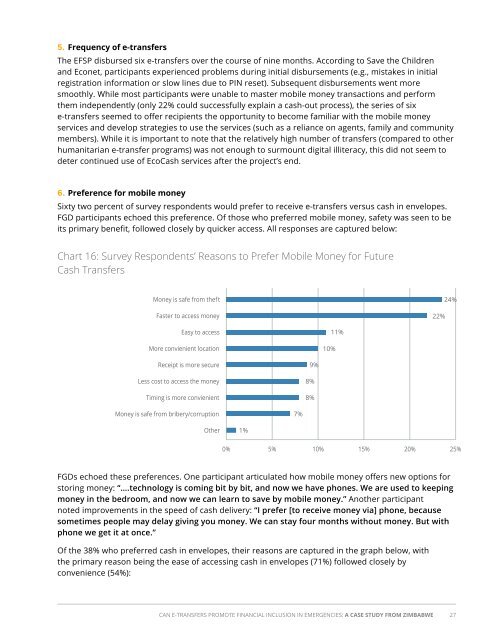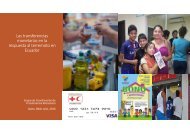Simatelele
2lF850q
2lF850q
Create successful ePaper yourself
Turn your PDF publications into a flip-book with our unique Google optimized e-Paper software.
5. Frequency of e-transfers<br />
The EFSP disbursed six e-transfers over the course of nine months. According to Save the Children<br />
and Econet, participants experienced problems during initial disbursements (e.g., mistakes in initial<br />
registration information or slow lines due to PIN reset). Subsequent disbursements went more<br />
smoothly. While most participants were unable to master mobile money transactions and perform<br />
them independently (only 22% could successfully explain a cash-out process), the series of six<br />
e-transfers seemed to offer recipients the opportunity to become familiar with the mobile money<br />
services and develop strategies to use the services (such as a reliance on agents, family and community<br />
members). While it is important to note that the relatively high number of transfers (compared to other<br />
humanitarian e-transfer programs) was not enough to surmount digital illiteracy, this did not seem to<br />
deter continued use of EcoCash services after the project’s end.<br />
6. Preference for mobile money<br />
Sixty two percent of survey respondents would prefer to receive e-transfers versus cash in envelopes.<br />
FGD participants echoed this preference. Of those who preferred mobile money, safety was seen to be<br />
its primary benefit, followed closely by quicker access. All responses are captured below:<br />
Chart 16: Survey Respondents’ Reasons to Prefer Mobile Money for Future<br />
Cash Transfers<br />
Money is safe from theft<br />
Faster to access money<br />
22%<br />
24%<br />
Easy to access<br />
More convienient location<br />
10%<br />
11%<br />
Receipt is more secure<br />
Less cost to access the money<br />
Timing is more convienient<br />
9%<br />
8%<br />
8%<br />
Money is safe from bribery/corruption<br />
7%<br />
Other<br />
1%<br />
0% 5% 10% 15% 20% 25%<br />
FGDs echoed these preferences. One participant articulated how mobile money offers new options for<br />
storing money: “….technology is coming bit by bit, and now we have phones. We are used to keeping<br />
money in the bedroom, and now we can learn to save by mobile money.” Another participant<br />
noted improvements in the speed of cash delivery: “I prefer [to receive money via] phone, because<br />
sometimes people may delay giving you money. We can stay four months without money. But with<br />
phone we get it at once.”<br />
Of the 38% who preferred cash in envelopes, their reasons are captured in the graph below, with<br />
the primary reason being the ease of accessing cash in envelopes (71%) followed closely by<br />
convenience (54%):<br />
CAN E-TRANSFERS PROMOTE FINANCIAL INCLUSION IN EMERGENCIES: A CASE STUDY FROM ZIMBABWE 27



